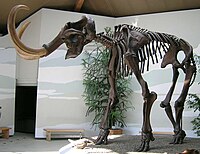
Photo from wikipedia
Abstract Dietary L-glutamine could be used as an antibiotic alternative to alleviate post-weaning and transport stress. However, the impact of supplementing L-glutamine to newly weaned and transported pigs on final… Click to show full abstract
Abstract Dietary L-glutamine could be used as an antibiotic alternative to alleviate post-weaning and transport stress. However, the impact of supplementing L-glutamine to newly weaned and transported pigs on final carcass and meat quality characteristics is currently unknown. Therefore, the objective of this study was to evaluate the impact of 0.2% dietary L-glutamine supplementation during post-weaning and transport recovery on carcass and meat quality attributes in pigs. A total of 480 mixed-sex pigs were studied in two production seasons, July-January and April-September (from weaning to harvest), where pigs were randomly assigned to 3 different diets (Non: no antibiotic, Anti: 441 ppm chlortetracycline and 38.6 ppm tiamulin, Gln: 0.20% L-glutamine with no antibiotics) for 14 days after weaning and transport, and then all pigs were fed a basal diet until reaching market weight. Pairs of longissimus dorsi (LD) and psoas major (PM) muscles were obtained from 1 d and 7 d postmortem carcass sides (n=10 gilts/dietary treatment/season replicate). Overall, no negative impacts of Gln were observed in carcass characteristics including loin eye area, back fat, and muscling score. Dietary Gln did not affect chemical and physical attributes of porcine muscles including pH, protein and lipid content, SF, and WHC (P > 0.05). The Gln treated pigs had decreased CIE L* and hue, suggesting enhanced color stability. April-September replicates had a faster pH decline, paler surface color, higher intra-muscular fat deposition, improved tenderness and water-holding capacity as indicated by lower shear force values, thaw-purge loss, and cooking loss compared to their July-January counterparts (P
Journal Title: Livestock Science
Year Published: 2020
Link to full text (if available)
Share on Social Media: Sign Up to like & get
recommendations!